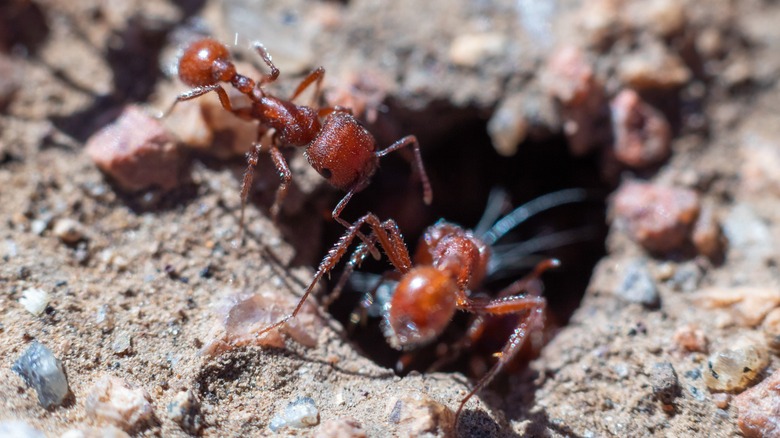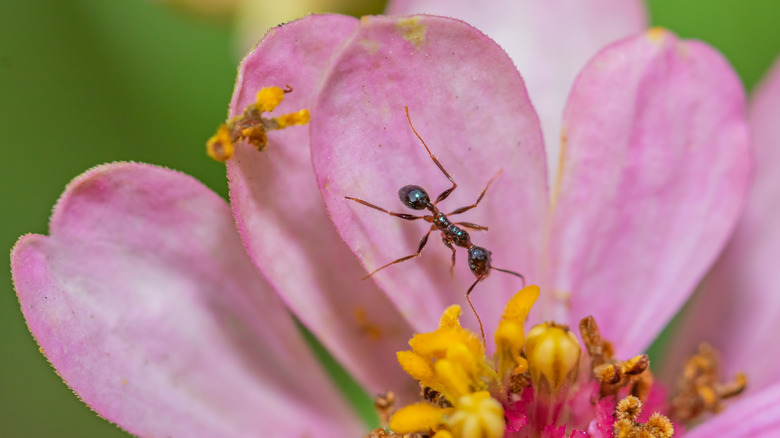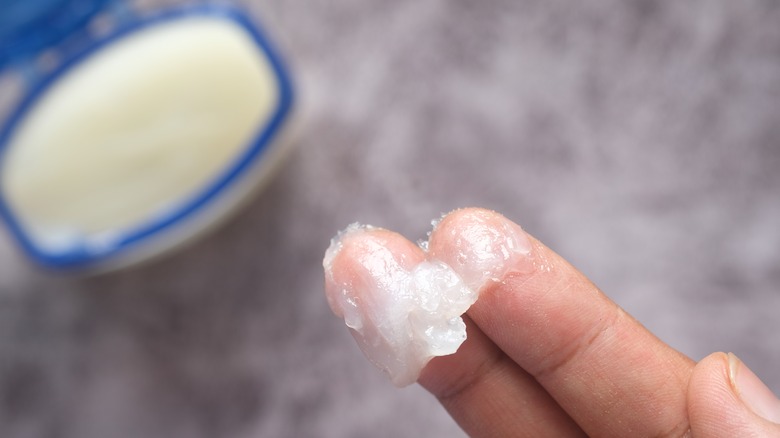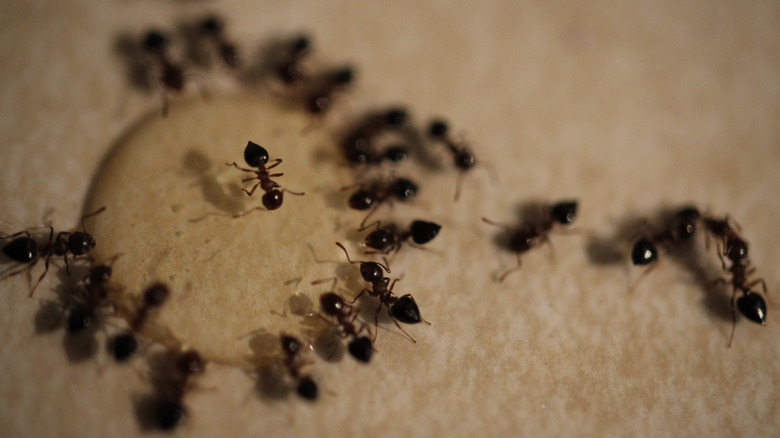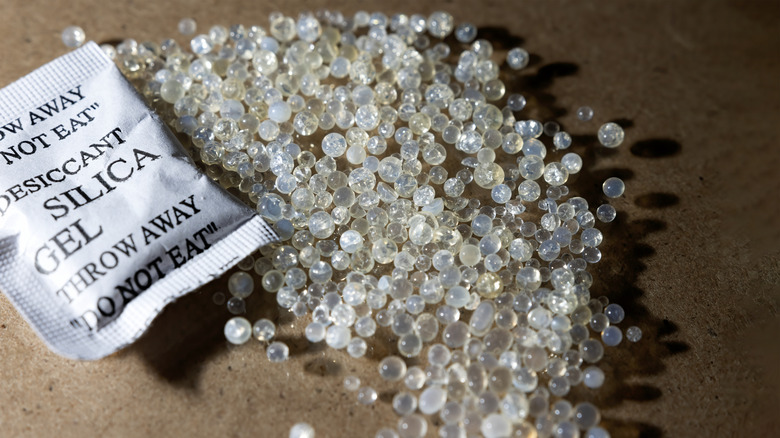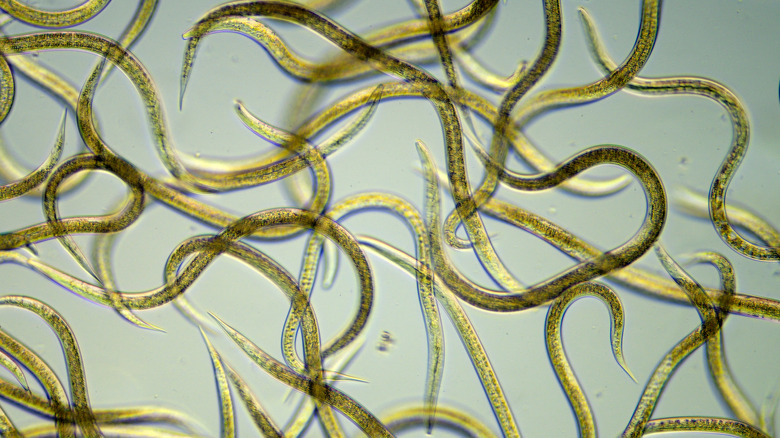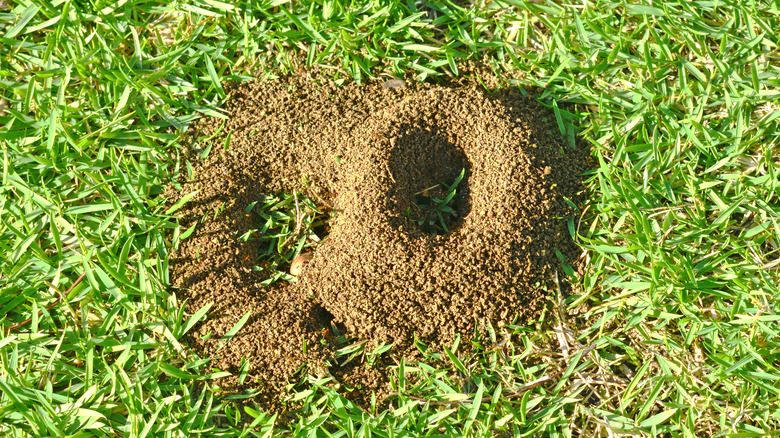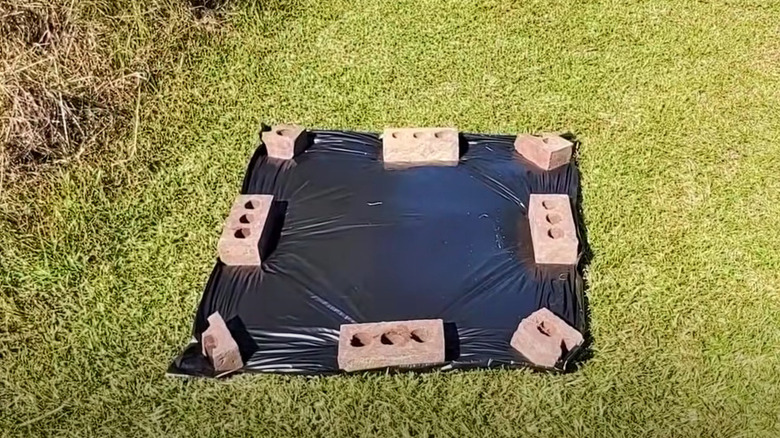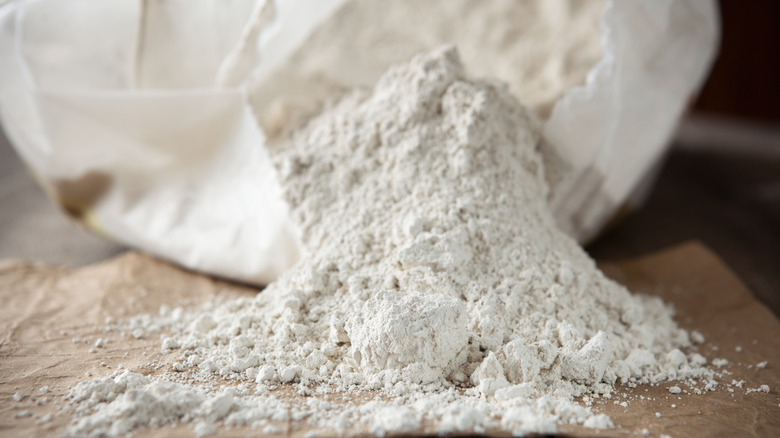Sneaky Tricks You Need When Dealing With Ants Nests
We may receive a commission on purchases made from links.
With a whopping 12,400 species of ants across the globe, chances are you've had a run in or two with these tiny pests. Not only can ants quickly become a nuisance, making their way into your living space, but they also have the ability to contaminate food, damage property, and leave mounds around the yard that render your lawn unattractive. Some species, such as fire ants, can also bite humans and pets, causing painful lumps that itch. If you spot ant nests in or around your home, you'll want to take immediate action to get rid of them.
While homeowners can head to the nearest garden center and pick up a batch of chemicals to eliminate the ants, there are a few other sneaky tricks that can be implemented instead that come with great success. Nests can be managed using everything from diatomaceous earth to citrus oil to beneficial nematodes. Combining several of the techniques listed below is best when creating a strategic approach to dealing with any ant infestation.
Use an insecticidal soap on indoor nests
Ant nests aren't just confined to outdoor spaces. It's also possible to have a nest indoors within the soil of one of your beloved potted plants. If this happens, you'll want to avoid the use of chemical sprays, and instead, focus on a more natural approach. Fortunately, you can deal with the nest using a homemade insecticidal soap that is completely safe to use around children and pets.
Take a bucket outside and combine a ½ cup of liquid dish soap with 1 gallon of water. You may need to double or triple this recipe if your plant pot is on the larger side. Place the indoor potted plant that is infested with ants inside the bucket. You want the soap solution to rise just above the soil's surface. Wait 20 minutes before removing the potted plant from the bucket and draining off any remaining insecticidal soap. All of the ants will now be deceased, and you can return your potted plant to its previous location.
Trap ants with petroleum jelly
Ants can't traverse petroleum jelly, so homeowners can actually use this easily-accessible product to create a barrier around the ants' nest. This sneaky trick prevents the ants from leaving the nest and making their way inside your home. It's important to note that petroleum jelly will eventually dry out, making it a only temporary method. Using the petroleum jelly will give homeowners time to implement a more permanent solution.
Locate the outdoor ants' nest and begin smearing a thick layer of petroleum jelly around the base. Make sure the petroleum jelly goes all the way around the base to create a complete barrier, and that you don't have any open spaces for the ants to escape. Check the barrier daily and apply more jelly if you notice the current layer starting to dry out. Repeat each day until you have time to implement another one of the control methods mentioned below.
Make your own Borax and sugar bait
In order to completely eliminate an ant colony, you need to use a bait that the worker ants will bring back to the nest. The bait contains a poison that will result in the death of any ant that feasts on it. Since ants are attracted to sugar, you can mix it with the ingredient Borax to lure the tiny insects. The Borax within the sugar bait is effective at killing ants, although control with baits is more slow-acting and can take as long as a week to produce results.
To make your own Borax and sugar bait at home, place 9 teaspoons of sugar in a cup of hot water. Add 1/2 teaspoon of Borax and stir until combined. Use a spoon to distribute this bait anywhere you've seen evidence of ants. This includes near nests, at the base of trees, and even inside your home, should the ants have already made entry. According to the University of California Agriculture & Natural Resources, the best time to apply the bait is in early spring or late winter, as there are less ants to deal with. Additionally, the university recommends combining control methods and not relying on baits alone.
Eliminate fire ant colonies with boiling water
If your yard is plagued with fire ant colonies, you'll find the cheapest control method available is quite effective. Boiling water, which you can get right from your tap for free, works to eliminate everything from fire ants to yellow jackets to termites. Texas A&M reports that boiling water is able to destroy fire ants 60% of the time. The university does recommend applying the boiling water only after first using a bait, like the Borax and sugar bait listed above.
Heat 3 gallons of water to at least 150 degrees Fahrenheit. After taking precautions to avoid getting burned, pour the water directly into the ants nests. You can also apply the boiling water to ant colonies using a pressure washer. Although boiling water is effective against ants, it can also kill any surrounding grass or vegetation, so you'll want to take that into consideration before utilizing this method. Additionally, if the ant colony survives, it will simply relocate its nest.
Use silica gel to dehydrate the ants
Ants have bodies that are covered in a waxy-type coating. When the insects come in contact with a desiccant, the coating is removed, and the pests are no longer able to retain moisture. This causes them to dehydrate and die. One common desiccant that can be used for this purpose is silica gel. It's quite affordable and also easy to apply.
It's unlikely you have enough silica gel packets on hand, so you'll want to grab a bottle of 100% silica gel dust from your local gardening center. You can also order it from Amazon. Insert the tip of the bottle inside the opening of the ants' nest and squeeze to send the dust inside the mound. You can also add a ring of dust around the base of the ant hill. If the dust gets wet, you will need to reapply it. While silica gel isn't poisonous to humans, the dust can enter the respiratory system during application and cause irritation, so it's important to wear a mask when implementing this sneaky trick.
Apply cinnamon leaf or citrus essential oil to kill fire ants
Another option when dealing with the nests of fire ants is to reach into your collection of essential oils and pull out either cinnamon leaf or citrus essential oil. Bioresource Technology reported on a study which revealed cinnamon leaf oil contains an element called trans-cinnamaldehyde, which was proven toxic to the ants. Citrus oil also contains an ingredient that is lethal to fire ants, d-limonene, making it an equally good choice.
Create your homemade essential oil insecticide by combining one part essential oil to every 99 parts water in a small bucket. Drenching the mound is an effective strategy, so you'll want to start by pouring the solution directly over the opening of the mound. Continue releasing the liquid over the outside of the mound, and then add the last bit of homemade insecticide around the base of the ant hill. Results will be evident within 48 hours; however, if the queen isn't eliminated with your treatment, you will need to repeat the treatment, or implement a secondary strategy from this list for full control.
Release nematodes for biological ant control
Biological control of ant infestations is also an option, thanks to microscopic creatures called nematodes. Nematodes are actually parasitic worms that naturally control the ants in your mound by penetrating the body of the ants and releasing a deadly bacteria. This is an excellent way to kill ants' nests without ruining your grass. In addition, nematodes are harmless to humans and pets, so they are quite safe to use in a family setting.
When purchasing nematodes, it's important that the product you select lists the specific type of ant colony you are dealing with. For example, some are only effective against fire ants, such as BioLogic's Scanmask, while others can eliminate a variety of ants, like Natures Good Guys Beneficial Nematodes. To apply the nematodes, you'll need to mix the packet with water. The amount of water doesn't matter, but you'll find using a pump or hose-end sprayer will help you get the job done quickly. Once combined, spray all of the mounds to release the nematodes.
Use neem oil directly on the nest
Neem oil has been used as a natural pesticide for many years, and in fact, the National Pesticide Information Center reveals it is an active ingredient in over 100 pesticides formulas. There are actually two components within neem oil that have insecticidal properties. These are azadirachtin and salannin, which are toxic to ants, but not people. When an ant comes into contact with neem oil, it becomes unable to eat or continue with the normal growth cycle. The result is death.
You can purchase a neem oil insecticide to get rid of your ants, or you can make your own at home. Fill a bucket with a gallon of water and add 5 tablespoons of clarified hydrophobic neem oil and 1 teaspoon of liquid dish soap. Combine the ingredients and either spray or pour the solution directly on and around the nest. Since this solution only works on contact, you'll need to repeat the application every 48 hours for two weeks to gain control over the ant population.
Dig up the mound and physically remove the ants
Take a careful look at your lawn or garden and determine whether your ant infestation is small or large. If you don't have a bunch of big ant mounds, you can actually dig them up and either kill them or relocate them. This sneaky trick is completely free and an excellent alternative to chemical control methods. It also provides immediate control, versus baits, which take time to fully eradicate ants.
Coat the end of a shovel with baby powder and then use it to dig up the ant mound. You can place the nest in a wheelbarrow and relocate it to a nearby wooded area. When this is not possible, shovel the mound directly into a bucket filled with hot water and a few tablespoons of a liquid dish soap. This will kill the ants. Use caution when digging up fire ant mounds, as they will sting, leaving behind painful bites. Note: Consider using this opportunity to teach your children about ant colonies and how they operate by transferring the ants you dig up to an ant farm.
Heat the mound with a trash bag
Did you know you can use a trash bag to relocate an ant colony? Ants prefer temperatures between 75 and 95 degrees Fahrenheit. When you raise the soil above 95 degrees, the ants become uncomfortable and begin their search for a new home. Additionally, ants in the larvae stage can't survive this temperature. The easiest way to raise the temperature of the soil in and around an ant hill is to place a black trash bag over the area.
Cut a black trash bag so that it fits over the ants' nest. You'll need heavy bricks to place around the perimeter of the trash bag to hold it firmly in place. Wait three days before removing the trash bag. You can check the temperature under the trash bag at any time with a thermometer if you want to be sure the temperature has risen above 95 degrees. Note: Although this method works to evict ants, the pesky insects will simply move to another area nearby, making it possible for them to return to the old nest later on. To prevent the ants from returning, surround the old nest with diatomaceous earth.
Eliminate ant nests using diatomaceous earth
When you spot an ants' nest among your beautifully landscaped property, you'll want to use a sneaky trick to kill the ants that won't ruin the grass. Diatomaceous earth is the answer! This all-natural product is a desiccant, like the silica gel mentioned above, that can be sprinkled around the nest. When the ants walk over it, the sharp edges of the dust pierce the ants' exoskeletons, which causes them to dehydrate and die.
Before you apply the diatomaceous earth, make sure you put on a mask, as the dust can irritate the lungs when inhaled. It's otherwise non-toxic to humans and pets. Sprinkle the diatomaceous earth over the entire mound. Afterward, create a barrier around the mound with the dust to make sure you get any ants coming and going from the nest. The only time this product loses effectiveness is if it gets wet, so you'll need to reapply it after a rainstorm.
